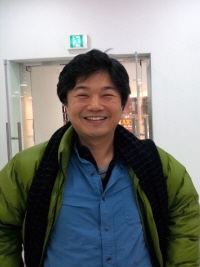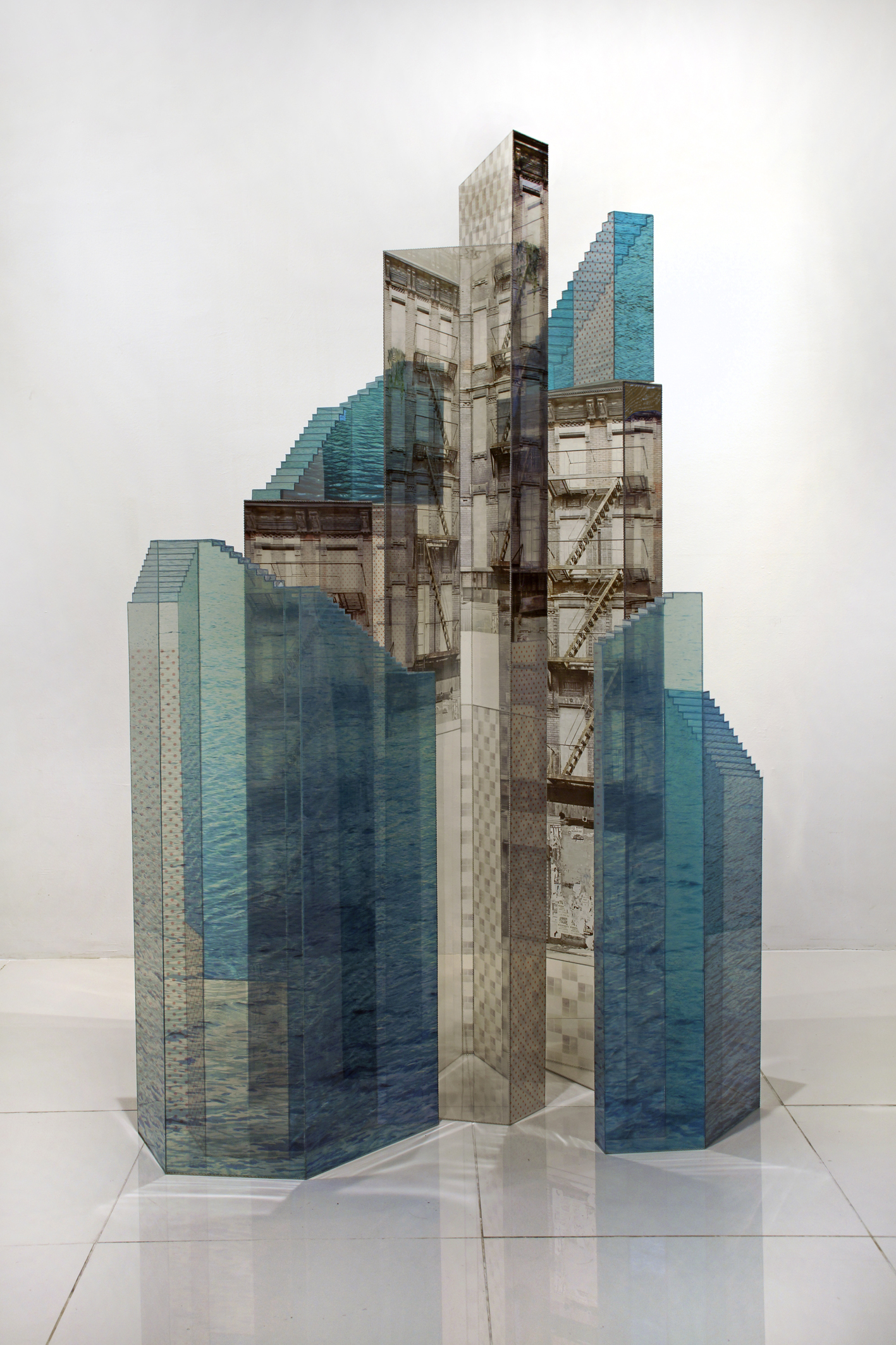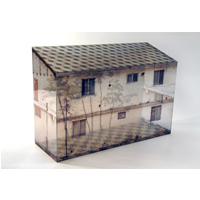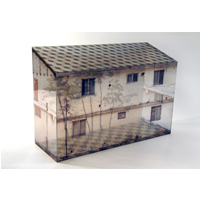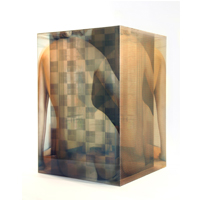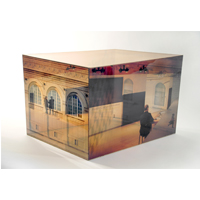Myungkeun KOH: Architecture of Photography
Myungkeun Koh turns two-dimensional photographs into three-dimensional sculptures. He photographs the surfaces of three-dimensional objects and constructs three-dimensional sculptures with collages of photographs. Paintings, sculpture, and photography thus become integral parts of a single work. Actuality is reconstructed, and the illusions imparted by the images are haunting. Photographs and sculptures, and architecture and illusionary images vibrate in multiple layers of a single body. Koh majored in sculpture in college and has been turning photographs into sculptures and applying photographs sculpturally for many years. His works transform two-dimensional photographs into three-dimensional spectacles that are very unlike conventional sculptures, and his works are a world apart from photographic works. If sculptures are represented by mass, form, and volume, Koh's sculptures, which are defined by the surface, are so light and so illusionary that they veritably share the realm of painting. Koh's sculptures are relatively free of the law of gravity and are not mass or form.
His works are creations of mechanical processes - photographing the objects, printing, and adjusting color ? and these processes are essential to their character. The process to print films and create a three-dimensional object with repeated layouts and a pile of printed photos requires exquisite and elaborate work. Subtle shade and shadow, changes in colors, and repeated photo images are superimposed in a way that creates a unique structure. To imitate the surface of an actual building, Koh first produces a miniature of the building. His three-dimensional artworks create curious architectural space and are fascinating, alluring, otherworldly boxes that seem to be of a different realm. The photographic images embody senses of reality and unreality at the same time. The surface of his box is a collage of many photos. By reconstructing photos by the use of the collage technique, Koh removes the documentary function of photography and intends to create another scene and reconstruct reality anew. Above all else, all his works are suggestive of a kind of architecture.
In his early years, Koh built a cylindrical or square 'building or structure' and collaged its surface with color or black-and-white photos of every kind of door and wall, and images printed on OHP sheets. Photos of dilapidated buildings and exterior walls and doors of collapsed buildings weathered over many years, which he used to enjoy photographing, are attached in tiny pieces or repeatedly attached on the surface of his sculpture. They are nothing but remains of urban civilization of modern times and historic sites, which impart nostalgia and fantasy at the same time. These dilapidated landscapes bleakly incite transience and a breakdown of this world and traces of death. After all, isn't photography nothing but contact with death and fossilization of live images?
All of Koh's sculptures are finished with light, transparent plastic. This solid plastic film that surrounds his work imparts a feeling of preservatives that prevents decay and freezes the breath of time while protecting photos. The concept is photographic images being frozen cold, and it is interesting that the images are hardened under the flexible modern material called plastic. This gives strange depth to his construct, and exposes and opens the transparent interior. The collage of photos intended to imitate actual images adds an unrealistic sense to his building all the more. Two-dimensional composition and composition as three-dimensional forms and installations or as an object are exquisite and fresh. And as Koh manipulates photos as a material medium freely, his work floats between reality and illusion of photo combination. The reality and sense of subject inherent in photography, standardized symmetry and outstanding skill in color sense apparent in Koh's works are very interesting in that the artist is materializing his view towards the world for himself by using photos which can accommodate images of reality in an extemporaneous way.
In his early years, Koh built a cylindrical or square 'building or structure' and collaged its surface with color or black-and-white photos of every kind of door and wall, and images printed on OHP sheets. Photos of dilapidated buildings and exterior walls and doors of collapsed buildings weathered over many years, which he used to enjoy photographing, are attached in tiny pieces or repeatedly attached on the surface of his sculpture. They are nothing but remains of urban civilization of modern times and historic sites, which impart nostalgia and fantasy at the same time. These dilapidated landscapes bleakly incite transience and a breakdown of this world and traces of death. After all, isn't photography nothing but contact with death and fossilization of live images?
All of Koh's sculptures are finished with light, transparent plastic. This solid plastic film that surrounds his work imparts a feeling of preservatives that prevents decay and freezes the breath of time while protecting photos. The concept is photographic images being frozen cold, and it is interesting that the images are hardened under the flexible modern material called plastic. This gives strange depth to his construct, and exposes and opens the transparent interior. The collage of photos intended to imitate actual images adds an unrealistic sense to his building all the more. Two-dimensional composition and composition as three-dimensional forms and installations or as an object are exquisite and fresh. And as Koh manipulates photos as a material medium freely, his work floats between reality and illusion of photo combination. The reality and sense of subject inherent in photography, standardized symmetry and outstanding skill in color sense apparent in Koh's works are very interesting in that the artist is materializing his view towards the world for himself by using photos which can accommodate images of reality in an extemporaneous way.
Koh photographed the skin of a building and skin of sculptures from various angles. His photos clipped the object in part, and then he reduced and enlarged it. And he edits them arbitrarily. The skin of a building and skin of a sculpture are moved onto the thin, transparent, shiny light plastic panels. A firm, heavy building and solid marble are now parasitic on thin panels with their heavy weights totally removed. Koh built a three-dimensional form by connecting those panels. Photographic images testify that it is a building, but it is a bizarre building. The artist printed photos on transparent plastic panels and connected these panels to produce a three-dimensional form, which is then installed in a space. In this way, two-dimensional photos are made three-dimensional. And, the skins of a building form a body to become a miniature of an actual building. Of course, this miniature is in a state completely different from the original building. It is very interesting to gather a building into the inside of my body and look at it. It is enjoyable to see 'a building' standing high or low according to the arbitrary direction and point of view of the artist. Koh's sculpture provides such an odd point of view.
Two-dimensional photos retain images but cannot materialize them. On the contrary, Koh makes two-dimensional photos structural and three-dimensional, and tells us that photos do not exist only on skins or planes. Photos can only reproduce the skin of a building or the skin of a body, and Koh makes them appear as the actual building or human body again by gathering and attaching tiny pieces of photo images, that is, making them into a sculpture by collage. This sculpture is built with images and skin, rather than only materials. When you think about it, most sculptures show the status of a certain material without images on its surface. If a photo is a realistic image on a two-dimensional plane, sculpture is substance that occupies real space. In contrast, Koh creates unique photo sculptures or photo installations through a happy encounter of photos based on illusion with sculpture drawn from materiality.
Koh has created a new form of sculpture, that is, transparent and light photo sculpture of which the skin is impregnated with images that are seen completely. The images themselves consist of the structure of this transparent photo sculpture. This way, the physical substance called sculpture meets the virtual images called photography. Their encounter is somewhat overlapped, deviating, and haunting in optical illusion, and this is due to its skin being compressed in multiple layers and plastic panels. In photographing the skin of a building and the skin of sculptures, deviation occurs depending on the time and direction from which the snapshots of each part were taken. Even if each and every snapshot is neatly connected to reproduce a panel on the whole, differences in color or light show in it. After all, it is reproduction of photography, which looks more like 'painting.'
The process by which Koh transforms photography into a three-dimensional form is very delicate and exciting. Each subtle shade and change in color, and each seemingly repeated snapshot imparts a unique feeling. Koh's sculpture is made like a miniature of a building with the intention of imitating the surface of an actual building, and it exists as a charming object in which sense of reality and sense of unreality coexist artfully by photo images. This 'Building' series with illusionary skin leads us to ponder the concept of time and history anew. This also applies to the existence of a building given to a certain space and human body surrounded by the space. With photos being printed on two-dimensional photographic paper and images impregnating on the surface, the appearance of the world that can be confirmed sensually becomes accurately reflected, and as photos began to be used as the most accurate means of documentation, reflection and imitation, techniques of fine art which were built based on illusions in previous times, began to lose their validity. And fine art is driven into an invisible realm: the world of the soul and mind and the world of the abstract.
Koh photographs sculptures. A three-dimensional object frozen at a specific moment of time is settled on two-dimensionally. The product of such process is revived as three-dimensional space once again or separated by innovative eyes to be made two-dimensional. The three-dimensional object photographed two-dimensionally is recomposed into the form of space in which the object actually exists. While reproducing the actual object, Koh cuts out the original condition in part to create folds and curves. He creates a new space by combining photography and sculpture, and this makes the new space look strange as he is 'cutting out' by discerning eyes. He shows us the process in which photos, which are fundamentally merely two-dimensional, transform the three-dimensional into the two-dimensional and in turn transform the two-dimensional into the three-dimensional again, and also presents the viewers a strange landscape that was partially cut out from the original context. Koh photographs an object from various angles to show photos that are two-dimensional, and then reconstructs them as three-dimensional. He also explores distortions and variations of forms through decalcomania. He plays with it. Paradoxically, he confirms to us the fact that photography is two-dimensional and at the same time leads us to think about the object and space we are looking at and other parameters of reality such as time. After all, I think Koh is using photography in a very interesting way, transforming images as he intends while at the same time inviting viewers to perceive an object in a new way and to enjoy sensuous play. By doing so, he offers viewers an opportunity for new experiences. He is now working on distortion and optical illusion that dramatizes or causes odd senses to collide as the transformation unfolds. When looking at an object and perceiving it, we humans automatically consider time and space as a matter of course and learn through experience. The question of how we humans perceive space visually seems very important to Koh. Photography as a medium is especially important to Koh because it is two-dimensional and is a means of reproduction and because photography changes and transforms images relatively freely.
Yeong-taek Park (Professor of Kyunggi University, Art critic)
more






